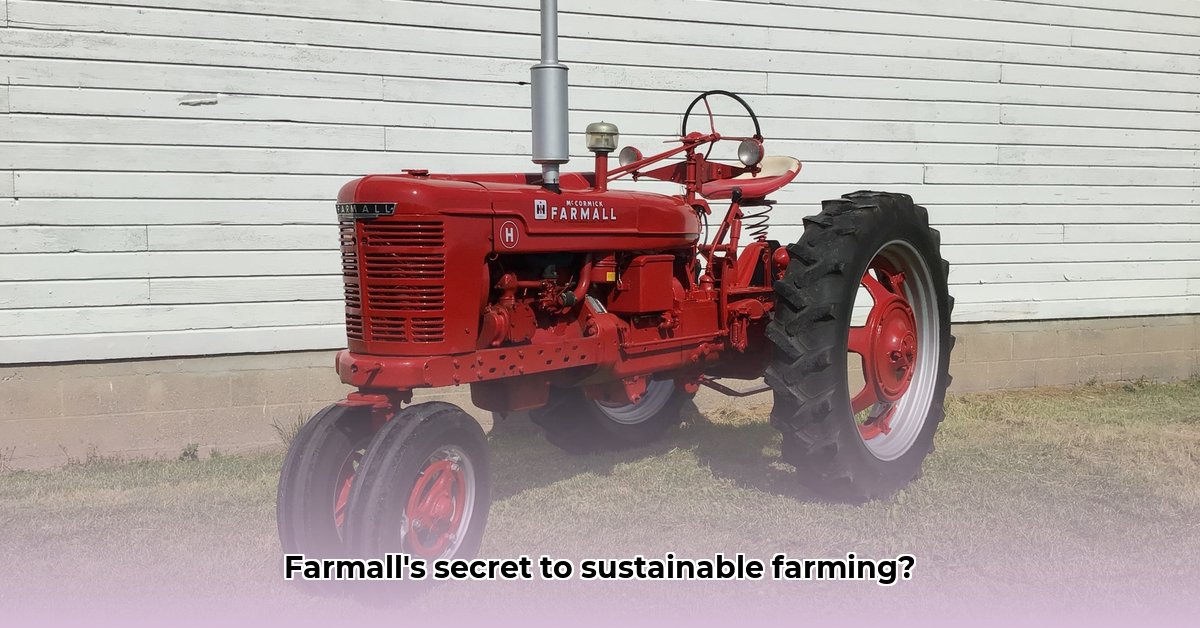
The Workhorse of a Changing Era: Introducing the 1950 Farmall
The post-World War II era witnessed a dramatic transformation in American agriculture. Enter the 1950 Farmall tractor, a symbol of this mechanization revolution. While boosting productivity, its impact on sustainable farming practices requires careful examination. This article delves into the design, historical context, and long-term implications of this iconic machine, offering a case study of technological advancement and its complex relationship with environmental stewardship. Did the Farmall pave the way for sustainable agriculture, or did it inadvertently sow the seeds of future challenges? Let's investigate. For more detailed specifications, see the 1950 Farmall specs.
Technical Specifications and Design: A Legacy of Durability
The 1950 Farmall models, including the popular Super M and H, were built for durability. Their robust construction—a hallmark of the era—meant less downtime for repairs and a longer operational lifespan. This inherent resilience, while not explicitly "sustainable" by modern standards, minimized resource consumption through extended machine life. The designs emphasized simplicity, making maintenance easier for farmers, reducing reliance on specialized mechanics. While fuel efficiency was relative to the technology of the time, the Farmall represented a significant leap forward in optimizing resource use compared to manual labor. Its design prioritized functionality and longevity, reflecting a practicality that, in some respects, mirrors contemporary ideals of sustainable resource management.
A Post-War Agricultural Revolution: Societal and Economic Shifts
The Farmall's impact extended beyond individual farms. It fueled a post-war agricultural boom, increasing yields and lowering labor costs. This mechanization, however, triggered significant societal and economic shifts. Larger farms became more economically viable, causing a consolidation that reduced the number of family farms and altered rural landscapes. This increased efficiency, while providing more food for a growing population, also raised concerns about soil health and biodiversity. This period saw a rise in monoculture farming, where large fields were planted with a single crop, intensifying pressure on soil nutrients and increasing susceptibility to pests and diseases – a practice that challenges the long-term health of the land.
Sustainability Analysis: Balancing Progress and Environmental Impact
Assessing the Farmall's contribution to sustainable agriculture requires a nuanced perspective. On the positive side, reduced reliance on manual labor improved working conditions and overall worker wellbeing. However, the tractor's dependence on fossil fuels—a significant factor in its operation—introduced environmental concerns. Increased fuel consumption contributed to greenhouse gas emissions, directly impacting air quality and global climate change. Furthermore, the ability to cultivate larger areas often led to increased soil compaction and erosion, hindering long-term soil fertility.
Examining the Debate: Soil Compaction and Sustainable Practices
The impact of tractor use on soil compaction remains a subject of ongoing debate. While larger tires and other technological advancements have mitigated this issue in more modern agricultural equipment, the Farmall, as a product of its time, lacked many of these features. Professor David Montgomery, a geologist at the University of Washington, emphasizes the importance of soil health in sustainable agriculture, stating, "Healthy soil is the foundation of a thriving ecosystem, and excessive compaction can severely compromise its ability to support plant life." Therefore, the Farmall's role in soil compaction needs to be understood within its historical context, reflecting a time when soil health was less of a consideration than today.
From Farmall to Modern Tractors: A Technological Leap for Sustainability
Modern tractors represent a significant technological advancement in sustainable agriculture. Compare them to the 1950 Farmall: contemporary models boast vastly improved fuel efficiency, often employing alternative fuels or advanced combustion techniques. Precision farming technologies, such as GPS-guided systems, allow for targeted applications of fertilizer and pesticides, minimizing waste and environmental impact. Reduced-tillage methods are also increasingly implemented and integrated into modern tractors. These factors contribute to a much more sustainable system compared to the capabilities of the 1950 Farmall.
Conclusion: A Legacy of Innovation and a Call for Sustainability
The 1950 Farmall tractor stands as a testament to human ingenuity and the transformative power of technology in agriculture. Its legacy, however, presents a complex narrative of progress and unintended consequences. While significantly improving efficiency and food production, the Farmall’s impact on soil health and reliance on fossil fuels highlights the importance of integrating environmental considerations with technological advancements in agriculture. Modern approaches to sustainable agriculture, incorporating precision farming techniques and renewable energy sources, reflect a commitment to balancing productivity with environmental responsibility – lessons learned from the successes and shortcomings of its predecessors, such as the 1950 Farmall. The story of the Farmall serves as a valuable reminder that future agricultural progress must prioritize long-term sustainability alongside improvements in efficiency and the wider farming ecosystem.